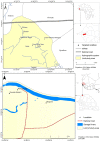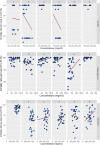Evaluation of the residual efficacy and physical durability of five long-lasting insecticidal nets (LLINs) in Senegal
- PMID: 35780153
- PMCID: PMC9250169
- DOI: 10.1186/s12936-022-04230-6
Evaluation of the residual efficacy and physical durability of five long-lasting insecticidal nets (LLINs) in Senegal
Abstract
Background: The preventive and curative strategies of malaria are based on promoting the use of long-lasting insecticidal nets (LLINs) and treating confirmed cases with artemisinin-based combination therapy. These strategies have led to a sharp decline in the burden of malaria, which remains a significant public health problem in sub-Saharan countries. The objective of this study was to determine and compare the residual efficacy of LLINs recommended by the World Health Organization.
Methods: The study was conducted in six villages in two sites in Senegal located in the Sahelo-Sudanian area of the Thiès region, 70 km from Dakar and in Mbagame, a semi-urban zone in the Senegal River Valley. A census was conducted of all sleeping places in each household to be covered by LLINs. Five brands of LLIN were distributed, and every six months, retention rates, net use, maintenance, physical integrity, insecticide chemical content, and biological efficacy were examined for each type of LLIN.
Results: A total of 3012 LLINs were distributed in 1249 households in both sites, with an average coverage rate of 94% (95% CI 92.68-95.3). After 36 months, the average retention rate was 12.5% and this rate was respectively 20.5%, 15.1%, 10%, 7%, and 3% for Olyset Net®, Dawa Plus® 2.0, PermaNet® 2.0, NetProtect® and Life Net®, respectively. The proportion of LLINs with holes and the average number of holes per mosquito net increased significantly during each follow-up, with a large predominance of size 1 (small) holes for all types of LLINs distributed. During the three-year follow-up, bioassay mortality rates of a susceptible strain of insectary reared Anopheles coluzzii decreased in the following net types: in Dawa Plus® 2.0 (100% to 51.7%), PermaNet® 2.0 (96.6% to 83%), and Olyset Net® (96.6% to 33.3%). Mortality rates remained at 100% in Life Net® over the same time period. After 36 months, the average insecticide content per brand of LLIN decreased by 40.9% for Dawa Plus® 2.0, 31% for PermaNet® 2.0, 39.6% for NetProtect® and 51.9% for Olyset Net® and 40.1% for Life Net.
Conclusions: Although some net types retained sufficient insecticidal activity, based on all durability parameters measured, none of the net types survived longer than 2 years.
Keywords: Durability; LLINs; Residual biological efficacy; Retention; Senegal.
© 2022. The Author(s).
Conflict of interest statement
The authors declare that they have no competing interests.
Figures






Similar articles
-
Survival of eight LLIN brands 6, 12, 24 and 36 months after a mass distribution campaign in rural and urban settings in Senegal.BMC Public Health. 2022 Apr 11;22(1):719. doi: 10.1186/s12889-022-13051-w. BMC Public Health. 2022. PMID: 35410149 Free PMC article.
-
Bio-efficacy of new long-lasting insecticide-treated bed nets against Anopheles funestus and Anopheles gambiae from central and northern Mozambique.Malar J. 2015 Sep 17;14:352. doi: 10.1186/s12936-015-0885-y. Malar J. 2015. PMID: 26377825 Free PMC article.
-
A cross-sectional study assessing the residual bio-efficacy and durability of field-distributed long-lasting insecticidal nets in malaria endemic ethnic communities of Assam, Northeast India.J Infect Public Health. 2016 May-Jun;9(3):298-307. doi: 10.1016/j.jiph.2015.10.005. Epub 2015 Nov 15. J Infect Public Health. 2016. PMID: 26589658
-
Comparative field evaluation of combinations of long-lasting insecticide treated nets and indoor residual spraying, relative to either method alone, for malaria prevention in an area where the main vector is Anopheles arabiensis.Parasit Vectors. 2013 Feb 22;6:46. doi: 10.1186/1756-3305-6-46. Parasit Vectors. 2013. PMID: 23433393 Free PMC article.
-
Comparative functional survival and equivalent annual cost of 3 long-lasting insecticidal net (LLIN) products in Tanzania: A randomised trial with 3-year follow up.PLoS Med. 2020 Sep 18;17(9):e1003248. doi: 10.1371/journal.pmed.1003248. eCollection 2020 Sep. PLoS Med. 2020. PMID: 32946451 Free PMC article. Clinical Trial.
Cited by
-
Physical durability and insecticidal activity of long-lasting insecticidal nets in Cruzeiro do Sul, Brazil.Sci Rep. 2024 Apr 19;14(1):9044. doi: 10.1038/s41598-024-59172-7. Sci Rep. 2024. PMID: 38641670 Free PMC article.
-
Evaluation of Durability as a Function of Fabric Strength and Residual Bio-Efficacy for the Olyset Plus and Interceptor G2 LLINs after 3 Years of Field Use in Tanzania.Trop Med Infect Dis. 2023 Jul 25;8(8):379. doi: 10.3390/tropicalmed8080379. Trop Med Infect Dis. 2023. PMID: 37624317 Free PMC article.
References
-
- WHO. World malaria report. Geneva, World Health Organization, 2021. https://apps.who.int/iris
-
- WHO. World malaria report. Geneva, World Health Organization, 2020. https://apps.who.int/iris
MeSH terms
Substances
LinkOut - more resources
Full Text Sources
Medical

